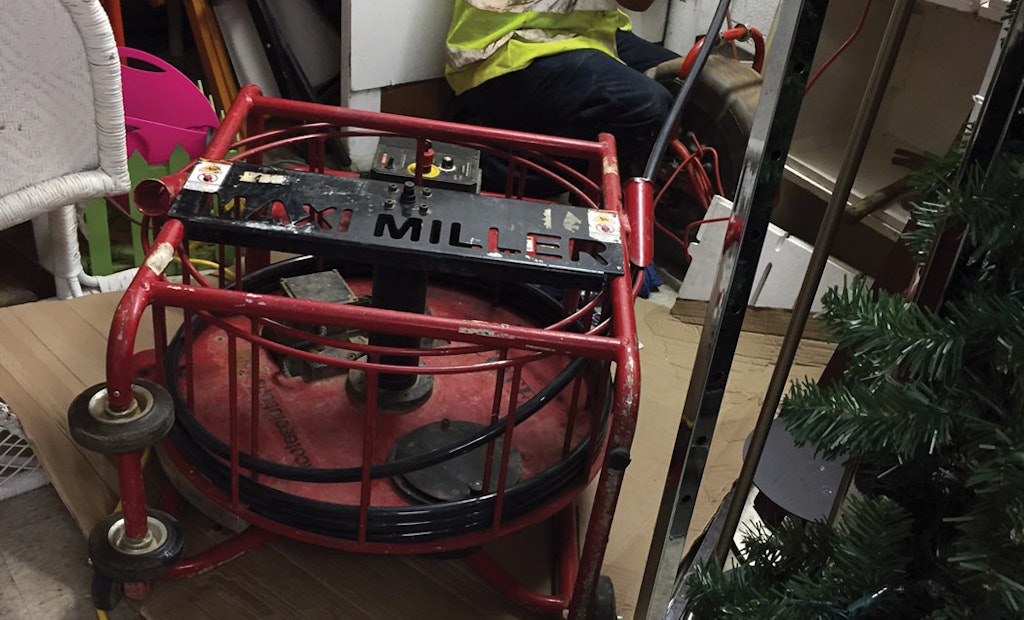
Nehemiah Martinez of All American Plumbers uses a Maxi Miller from Picote Solutions to descale a 4-inch-diameter cast-iron sewer line at a commercial shopping center.
Interested in Relining/Rehab?
Get Relining/Rehab articles, news and videos right in your inbox! Sign up now.
Relining/Rehab + Get AlertsEven the best pipe lining contractors periodically experience collapsed liners. But as Ricky Salinas can attest, fixing a collapsed liner doesn’t have to be financially disastrous, thanks to the Maxi Miller from Picote Solutions.
“No matter how good your technicians are, you’re going to run into a liner failure at some point, either due to your own error or something completely out of your control,” says Salinas, the co-owner of All American Plumbers. Based in Manassas, Virginia, and established in 2003, the company has 25 employees and serves customers in northern Virginia and Maryland. Salinas’ business partner is John Bounds. “If it fails, most times you have to dig in order to repair it.
“But sometimes it’s inaccessible or too expensive to excavate,” he continues. “That’s where the Maxi Miller comes in.”
Designed primarily as a drain cleaning machine, the Maxi Miller — which weighs about 210 pounds and is designed to work in 4- to 8-inch-diameter pipes — can be outfitted with different attachments that turn it into a multifaceted and versatile tool. In this case, Salinas uses a cutting head that’s designed to drill through fallen liners in 4- to 6-inch-diameter pipe. Then he employs a sanding head that utilizes four spinning grinding panels that smooth out the rough cut left by the cutting head, Salinas says.
“The cutting head is similar to a drill bit,” Salinas explains. “It’s specifically designed to drill through a liner. After you drill through it, we change the head to a sander that spins at such a rate of speed that it smooths out the rough cut created by the drill. Before you know it, you’re back down to the original pipe, which is ready to be lined again.”
Before Salinas invested in the Maxi Miller, which is powered by a 1,400 rpm electric motor with output of 1,130 watts, excavation was the only option for repairing collapsed liners. Depending on where the failure occurs, how deep the pipe is and what’s above ground at that point, excavation work can cost anywhere from $5,000 in a residential yard with no obstructions to $20,000 if the collapse occurs under a street, he estimates.
One extreme incident that occurred about four years ago illustrates the Maxi Miller’s value. An All American Plumbers crew was lining a 30-foot stretch of sewer lateral under a building in Georgetown in the District of Columbia. When the liner collapsed, the only option was to hand-dig a 5-foot-long tunnel and replace a section of the lateral with PVC pipe.
“It was a desperate measure,” Salinas recalls. “Excavating from above wasn’t an option because it would have bankrupted my company. It’s the only time I ever worked for 48 hours straight without any food or sleep. We had to get the job done … and it nearly killed me. That’s when I started looking for an alternative.”
Salinas first saw the Maxi Miller at the 2013 Pumper and Cleaner Environmental Expo International (now the WWETT Show). But he waited two years before buying one. “It seemed too good to be true,” he says. “I was afraid it would be one of those pass-through products, so I wanted to see how it would evolve, be sure it was something that was going to stick. And sure as hell, it stuck.”
In fact, the Maxi Miller impacted the company more than Salinas initially envisioned, due to its versatility. He says that when paired with a descaling chain attachment, the machine reams out pipes more effectively than high-pressure water jetters he owns and does so without damaging pipes. This improved capability has opened up a new market for the company.
“We dramatically improved our drain cleaning service,” Salinas says. “The Maxi Miller uses a chain (attachment) that’s specifically designed for a 4-inch-diameter cast iron pipe. It runs at such a high rate that it lifts itself up (via centrifugal force), so the force is evenly distributed all the way around the pipe walls. It generates a very focused punch right where you want it.
“It might take our guys one to three days to descale a pipe, but the Maxi Miller can do the same job in one to three hours,” he continues. “My business partner got mad when I bought the machine. But now he’s a believer, too, because we’re doing almost three times more descaling jobs and delivering a better final product to our customers.”
Furthermore, by using yet another attachment, the Maxi Miller can reinstate lateral lines after pipe lining is complete. “It’s changed how we operate, big-time,” Salinas says. “We can charge a fair-market rate for both descaling and for reinstatements. And after the initial investment, the only real cost to use the Maxi Miller is labor. It paid for itself almost four-fold after one year. It’s really a phenomenal product.”





